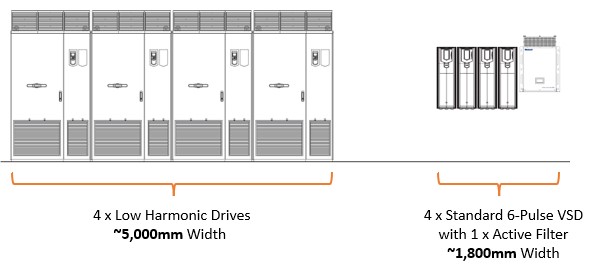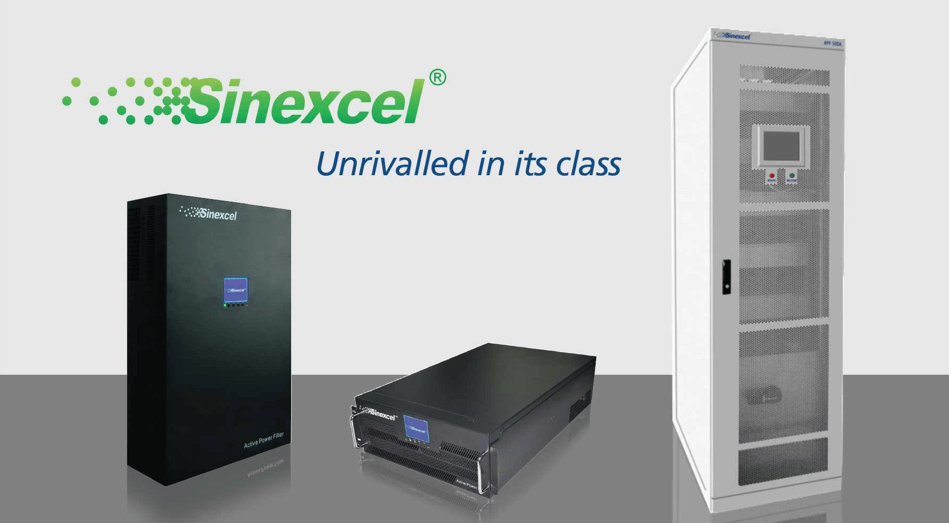Active Filters vs. Low Harmonic Drives
Active Filters vs. Low Harmonic Drives
Cost Effective Harmonic Mitigation for Duty/Standby VSD Applications
In recent times, the use of high-power Low Harmonic Drives (LHD’s) has increased. However, do their benefits outweigh their cost and space demands? Or do more cost-effective solutions exist? With our experience in the field, we believe that Active Harmonic Filters are still the preferred choice in many applications.
Active Filters vs. Low Harmonic Drives for Duty/Standby VSD applications
Active Filters offer two main advantages over Low Harmonic Drives – cost and physical size (footprint). The Active Harmonic Filter (AHF) for group compensation dramatically reduces the overall project capital and operational expenses for high-power duty/standby VSD applications.
A high-power Low Harmonic Drive (LHD) is physically very large compared to standard Variable Speed Drive (VSD) and quite often proves to be an over-kill solution, particularly for duty/standby applications. If multiple motors are used in duty/standby arrangements, then the compactness of the standard VSD can be taken advantage of when the harmonic solution is separated out and engineered to actual design targets and compliance requirements. The active filter fulfills this requirement and can be quite compact and an efficient solution. In most modern applications, the smaller physical footprint is a tremendous advantage when real estate in switchrooms is so precious.
Physical size advantages need to be considered in the design phase
It's often too late at the final construction phase to transform this simplistic power engineering design below to a design that carefully considers harmonics. Please note the significant savings in the real estate required for this solution. Therefore, these aspects need to be taken into consideration during the design phase to optimise these benefits.
What makes Active Filter based harmonic solutions cost-effective?
- The compact group compensation design can greatly reduce switchroom dimensions and transport costs to site, compared to Low Harmonic Drive alternatives.
- The parallel connected AHF works when it needs to and not all the time like Low Harmonic Drives, further improving operational efficiencies.
- Unlike Low Harmonic or Active Front Drives, if the design compliance target is based on THvD according to Australian standards, the active filter may only need to treat a portion of the harmonic current spectrum of the loads, not all of it. Additionally, if the VSD loads are a combination of duty & standby applications, it would prove to be the most cost-effective and most efficient total solution.
- A separate and flexible “group compensation” topology utilising precise active filter selections can ultimately save on physical space, improve efficiencies, enabling the engineer to design to actual targets and radically change the electrical infrastructure costs.
- It can be configured to treat only what’s required. It does this while parallel coupled to the loads. For example, without carrying full load current of the VSD’s.
- It can be configured to focus on one or another harmonic through individual parameter settings if required. For example, it’s not a “blanket” overkill solution, in-line with the load.
- It is designed to meet the most stringent requirements according to AS/NZ standards & IEEE recommendations, adopted by most electricity distributors.
- It allows more compact VSD’s to be used, compared to ones that might include passive or active in-line harmonic solutions. This can help reduce overall project costs including lowered switchroom & delivery costs.
- With a harmonic mitigation solution separated out like this, the VSD selections can remain stable, therefore not impacting total project designs through the various project cycles and eventual project construction.
Sinexcel Active Harmonic Filters
With their unique modular design and 3-level topology performance, Sinexcel Active Harmonic Filters offer a highly flexible, reliable and customisable solution in active harmonic compensation systems.
Why Fuseco?
At Fuseco we specialise in Power Quality. We can be active participants in those crucial early concept phase discussions regarding the various harmonic solutions available. There are many techniques that can be utilised and there is room for all of those when applied correctly.
Please contact the team at FUSECO for further information and completive pricing on the Sinexcel Active Harmonic Filter range and all your Power Quality requirements.
We're here to help
Talk to an expert today.
Our friendly team of highly trained specialists will quickly assist you.
We promise to respond within 4 business hours (AEST).
Or you will receive $100 off your next purchase. Read how it works.
Top FAQs
VIC - HEAD OFFICE / WAREHOUSE
27 Viking Court
Cheltenham VIC 3192
NSW - SALES OFFICE / WAREHOUSE
29/8-10 Barry Road
Chipping Norton NSW 2170
QLD - SALES OFFICE
1 / 26 Duke Street
Sunshine Beach QLD 4567
WA - SALES OFFICE
67 Howe Street
Osborne Park WA 6017
We'd love to hear from you! At Fuseco, rather than publish generic prices, we prefer to give you an individual quote. This ensures that we provide you with the best possible pricing to meet your needs.
The quickest way to place an order is to give our customer service team a call or send us an email. We promise to respond within 4 hours or you get $100 off your next order, however we usually respond within 1-2 hours to email enquiries. So go ahead and speak to us, we'd love to help you with your needs.
Fuse Products
- For all orders over $100 (excl. GST & freight), freight is FIS (Free into Store).
- For all orders under $100 (excl. GST & freight), a freight charge of $25 + GST is applicable.
- Additional fees may apply for deliveries to the Northern Territory and remote areas.
All Other Products
- Freight charges POA (Price on Application)
- FOT (Customer nominates own carrier and accepts all charges)
In simple terms, harmonics are extra frequencies that when present in an electrical circuit, distort the AC sine wave. A harmonic of a wave is a component frequency of the signal that is an integer multiple of the fundamental frequency. For example, if the fundamental frequency is f, the harmonics have frequencies 2f, 3f, 4f... etc.
Harmonic frequencies are equally spaced by the width of the fundamental frequency and can be found by repeatedly adding that frequency. In the case of the Australian electricity supply, the fundamental frequency is 50Hz. The frequencies of the harmonics are 100Hz, 150Hz, 200Hz, 250Hz, 300Hz, 350Hz and so on.
For electrical systems to function in their intended manner without significant loss of performance or life, they require a supply of electricity that is of good quality. Good quality electrical power has the following characteristics:
- It must have a continuity of service (not be interrupted).
- It must have a very low Harmonic content.
- It must have a very low variation in the voltage magnitude.
- It must have very low transient voltages and currents.
The term 'clean power' is used to describe electricity that is considered to be of good quality (see above) with particular reference to a very low harmonic content. Therefore, the term 'dirty power' is used to describe electricity that is considered to be of low quality (opposite to the above) with particular reference to a very high harmonic content.
In Australia, our electricity is supplied in alternating current at a frequency of 50Hz. In alternating current (AC) the movement of electric charge periodically reverses direction. In direct current (DC), the flow of electric charge is only in one direction. 50Hz means that the AC has a frequency of 50 cycles per second. This is also known as the 'fundamental' frequency. AC is the form in which electricity is delivered to businesses and residences. Most electrical devices (such as motors) need clean electricity to function properly. This means that the electrical supply needs to be a clear sinusoidal wave.
If you occasionally experience some unexplained occurrences such as flickering lights, alarms going off, or MCB's, MCCB's, RCD's and Earth Leakage devices tripping for no apparent reason, you are most likely experiencing harmonics in your electrical environment. Other signs are cables running hot, hot switchboards or overheating motors. If you are replacing your motor's bearings & insulation often, that's a strong indication of the presence of harmonics.
Learn more
Harmonics are very harmful within an electrical system and can have serious consequences. For example, the presence of harmonics reduces the life of equipment. It is possible that the investment that you made in your motors & drives will not be realised if they are damaged and need replacing before their expected life span. This can be very expensive. Harmonics cause things to run hot, which cause stress on the cables and equipment.
In the long term, this degrades an electrical system. The presence of harmonics will also mean that although you will get billed for the power that you are supplied, a large percentage of that power may be unusable. Harmonic mitigation is taking action to minimise the presence of harmonics in your electrical system and can achieve great cost savings.
Variable Speed Drives (also known as Variable Frequency Drives) are prolific creators of harmonics in electrical systems and as a result, most of the harmonic mitigation effort focuses on the input side and output side of a VFD.
Depending on the specific situation, there are a variety of products that are used to mitigate harmonics. Fuseco's Power Quality Consultants can assist by conducting a site analysis or simply providing advice based on the details of the particular electrical system. Here is a brief summary of the product groups:
Line (input) side of the VSD
Device Features:
- Line Reactors Simple & cost-effective method to reduce harmonics. Available in 3% & 5% versions.
- Passive Harmonic Filters Significantly reduces harmonics from the VSD back out to the system and also improves true power factor.
- Meets the IEEE519 Standard.
- Active Harmonic Filters Active filters inject a 180 degree inverse current to nullify the harmonic content going back out to the system. They mitigate harmonics, compensate for voltage dips & can handle multiple VSD's relative to the reactive power required. Meets the IEEE519 Standard.
Load (output) side of the VSD
Device Features:
- Load Reactors Simple & cost-effective method to reduce harmonics. Available in 3% & 5% versions.
- dV/dT Filters dV/dT filters have been designed to limit peak voltage and increase voltage rise time. In addition to mitigating harmonics, the dV/dT filter also clips voltage spikes.
- Sinewave Filters The ultimate load side harmonic mitigation product. Filters all harmonics, including reflective currents, eddy currents, common mode currents. Can be used for long cable runs (many kms). Stops the heating of cables. Great for the longevity of motors.

From the moment the AHF and SVG units were turned on our power factor issues were a thing of the past. At both sites our PF is now 0.99 on all phases all the time, the units react instantaneously to our fluctuating load and power factor and the result has been an excellent return on investment.
Brad Kilner
OPERATIONS MANAGER AT KILNER'S ENGINEERING
Technical Support
Our experts are all pre-eminent leaders in electrical products who provide excellent support in their areas of expertise.
Technical supportTalk to an expert
Our friendly team are highly trained product experts who really enjoy helping customers find what they need.
call 1300 387 326Enquire by email
We promise to respond within 4 business hours (AEST) or you will receive $100 off your next purchase.
Enquire now

